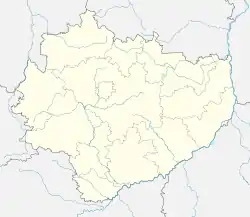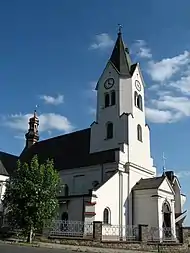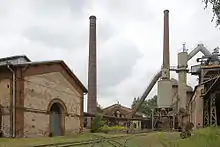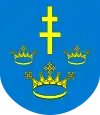Starachowice
Starachowice [staraxɔˈvʲit͡sɛ] (![]() listen) is a town in south-central Poland (historic Lesser Poland), with 49,513 inhabitants (31.12.2017). Starachowice is situated in the Świętokrzyskie Voivodeship (since 1999); it was formerly in the Kielce Voivodeship (1975–1998). It is the capital of Starachowice County. It is situated upon the River Kamienna, a tributary of the Vistula River, among hills and forests.
listen) is a town in south-central Poland (historic Lesser Poland), with 49,513 inhabitants (31.12.2017). Starachowice is situated in the Świętokrzyskie Voivodeship (since 1999); it was formerly in the Kielce Voivodeship (1975–1998). It is the capital of Starachowice County. It is situated upon the River Kamienna, a tributary of the Vistula River, among hills and forests.
Starachowice | |
|---|---|
.jpg.webp) County administration building | |
 Flag  Coat of arms | |
 Starachowice  Starachowice | |
| Coordinates: 51°3′N 21°4′E | |
| Country | |
| Voivodeship | Świętokrzyskie |
| County | Starachowice County |
| Gmina | Starachowice (urban gmina) |
| Established | 15th century |
| Town rights | 1624 as Wierzbnik |
| Government | |
| • Mayor | Marek Materek |
| Area | |
| • Total | 31.85 km2 (12.30 sq mi) |
| Elevation | 252 m (827 ft) |
| Population (31.12.2017) | |
| • Total | 49,513 |
| • Density | 1,600/km2 (4,000/sq mi) |
| Time zone | UTC+1 (CET) |
| • Summer (DST) | UTC+2 (CEST) |
| Postal code | 27-200 |
| Area code(s) | +48 41 |
| Car plates | TST |
| Website | www |
History

In the location of present-day Starachowice, a forge existed, which in the 16th century belonged to the Starzechowski family (most probably, the name of the town comes from this family). The oldest known mention of Starachowice comes from 1547.[1] The settlement, which was built around the forge, belonged until 1817 to the Cistercians from Wąchock Abbey, located nearby. It was the monks who in 1789 initiated construction of a blast furnace (see also Old-Polish Industrial Region). In the meantime Polish bishop Bogusław Radoszewski founded the town of Wierzbnik in 1624, which was granted town rights by Polish King Sigismund III Vasa.[1] Three annual fairs and three weekly markets were organized in the town, however it developed slowly, while Starachowice developed faster.[1] Both settlements were administratively located in the Sandomierz Voivodeship in the Lesser Poland Province of the Polish Crown.
In the Third Partition of Poland, in 1795, the area was annexed by Austria, in 1809 it passed to the short-lived Polish Duchy of Warsaw, and in 1815 it passed to so-called Congress Poland in the Russian Partition of Poland. In 1815, the furnace was taken over by the government of Congress Poland, and in the following years, the industrial settlement of Starachowice emerged as main center of metallurgy. According to a plan devised by Stanisław Staszic, metal industry was developed along the Kamienna river, and the settlement of Starachowice was its center. As part of anti-Polish repressions following the unsuccessful Polish January Uprising, the Russian administration stripped Wierzbnik of its town rights in 1870, which were restored in 1916.[1]
After Poland regained independence in 1918, the government in Warsaw decided to build an arms factory in Starachowice. On October 12, 1920, The Society of Starachowice Mining Company signed a contract with Main Office of Supplying the Army. Soon afterwards, works on construction of artillery ammunition factory began. Zakłady Starachowickie (Starachowice Works), which was an industrial complex including ammunition factory, artillery equipment factory and iron works, was main Poland’s producer of such materiel. It also manufactured Bofors 37 mm guns, used by the Polish Army in 1939. The very town of Starachowice was not created until April 1, 1939, when the ancient town of Wierzbnik was merged with the settlement of Starachowice Fabryczne and the village of Starachowice Górne. At first, the new town was named Starachowice-Wierzbnik, and in 1952 the name was changed into Starachowice.
During the German invasion of Poland, which started World War II, the Einsatzgruppe II entered Starachowice on September 27, 1939 to commit various crimes against Poles.[2] During World War II it was occupied by Germany and in 1940 the Germans carried out mass arrests of local Polish intelligentsia.[3] Poles were used as forced labour in the local factory.[1] During the Holocaust, the ghetto in Wierzbnik was liquidated on October 27, 1942, and many of its prisoners were sent to the death camp Treblinka. The remaining Jewish residents of Starachowice and Wierzbnik were sent to German labor camps in the vicinity. Those camps were liquidated in the summer of 1944. The remaining survivors were deported to Auschwitz where many of them met their deaths at the hands of the Schutzstaffel. There was a munition plant there where Jewish slave labor was used.
During World War II, Starachowice was an important center of the Home Army, where units of Jan Piwnik and Antoni Heda operated.
After the war, the town prospered as an important industrial center. Besides Starachowice Works, truck producer FSC Star was opened in 1948. A Star truck was used as the basis for the first Popemobile for Pope John Paul II's during his first visit to his home country as Pope of the Roman Catholic Church (1979). When capitalist system was reintroduced in 1989, the situation in Starachowice worsened, and unemployment grew drastically. The town currently has a special economy zone with lower tax rates to help the settlement of new industry.
Sport
There is the Municipal Stadium in the city. Local football teams are:
- Star Starachowice, a football club which for several years played in the Second Division
- Juventa Starachowice - football club
.JPG.webp)
.JPG.webp)

Notable residents
- Bogusz Bilewski (1930–1995), Polish actor
- Krystyna Janda (born 1952), Polish film and theater actress
- Krzysztof Lipiec (born 1959), Polish politician and member of the Sejm (Polish parliament)
- Rafał Wójcik (born 1972), Polish long-distance runner
International relations
References
- "Historia". Starachowice.eu (in Polish). Retrieved 11 September 2020.
- Maria Wardzyńska, Był rok 1939. Operacja niemieckiej policji bezpieczeństwa w Polsce. Intelligenzaktion, IPN, Warszawa, 2009, p. 58 (in Polish)
- Wardzyńska, p. 251
| Wikimedia Commons has media related to Starachowice. |
